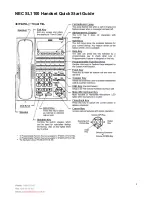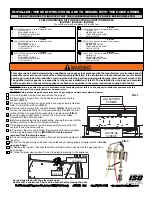
User's Guide Babyface Pro
© RME
77
26.2 Latency and Monitoring
The term
Zero Latency Monitoring
was introduced by RME in 1998 for the DIGI96 series of
audio cards. It stands for the ability to pass-through the computer's input signal at the interface
directly to the output. Since then, the idea behind has become one of the most important fea-
tures of modern hard disk recording. In the year 2000, RME published two ground-breaking
Tech Infos on the topics
Low Latency Background
, which are still up-to-date:
Monitoring, ZLM
and ASIO
, and
Buffer and Latency Jitter
, both found on the RME website.
How much Zero is Zero?
From a technical view there is no zero. Even the analog pass-through is subject to phase er-
rors, equalling a delay between input and output. However, delays below certain values can
subjectively be claimed to be zero latency. This applies to analog routing and mixing, and in our
opinion also to RME's Zero Latency Monitoring. The term describes the direct digital path from
the interface’s input to output. Digital receiver buffers plus TotalMix and output transmitter shoiw
a typical delay of 3 samples. At 44.1 kHz this equals about 68 µs (0.000068 s), at 192 kHz only
15 µs. The delay is valid for ADAT and SPDIF in the same way.
Oversampling
While the delays of digital interfaces can be disregarded altogether, the analog inputs and out-
puts do cause a significant delay. Converter chips operate with 64 or 128 times oversampling
plus digital filtering. This typically generates a delay of one millisecond. A playback and re-
record of the same signal via DA and AD (loopback) causes an offset to the newly recorded
track of about 2 ms.
Low Latency!
The Babyface Pro uses AD/DA converters with latest digital filters, causing a delay of only a few
samples. With 12 samples AD and 7 samples DA the delay caused by the conversion is only
about a quarter of previous generations. The delays of the Babyface Pro’s AD/DA are:
Sample frequency kHz
44.1
48
88.2
96
176.4 192
AD (12.6 x 1/fs) ms
0.28 0.26
AD (12.6 x 1/fs) ms
0.14
0.13
AD (10 x 1/fs) ms
0.056 0.052
DA (7 x 1/fs) ms
0.16 0.15 0.08
0.07
0.04
0.036
Buffer Size (Latency)
Windows:
This option found in the Settings dialog defines the size of the buffers for the audio
data used in ASIO and WDM (see chapter 10).
Mac OS X:
The buffer size is defined within the application. Only some do not offer any setting.
For example iTunes is fixed to 512 samples.
General:
A setting of 64 samples at 44.1 kHz causes a latency of 1.5 ms, for record and play-
back each. But when performing a digital loopback test no latency/offset can be detected. The
reason is that the software naturally knows the size of the buffers, therefore is able to position
the newly recorded data at a place equalling a latency-free system.
AD/DA Offset under ASIO and OS X:
ASIO (Windows) and Core Audio (Mac OS X) allow for the
signalling of an offset value to correct buffer independent delays, like AD- and DA-conversion or
the Safety Buffer described below. An analog loopback test will then show no offset, because
the application shifts the recorded data accordingly. Because in real world operation analog
record and playback is unavoidable, the drivers include an offset value matching the Babyface
Pro converter delays.
Therefore, in a
digital
loopback test a
negative
offset of about 3 ms occurs. This is no real
problem, because this way of working is more than rare, and usually the offset can be compen-
sated manually within the application. Additionally, keep in mind that even when using the digital
I/Os usually at some place an AD- and DA-conversion is involved (no sound without...).
Содержание Babyface Pro
Страница 5: ...User s Guide Babyface Pro RME 5 User s Guide Babyface Pro General...
Страница 11: ...User s Guide Babyface Pro RME 11 User s Guide Babyface Pro Installation and Operation Windows...
Страница 28: ...28 User s Guide Babyface Pro RME...
Страница 29: ...User s Guide Babyface Pro RME 29 User s Guide Babyface Pro Installation and Operation Mac OS X...
Страница 38: ...38 User s Guide Babyface Pro RME...
Страница 39: ...User s Guide Babyface Pro RME 39 User s Guide Babyface Pro TotalMix FX...
Страница 41: ...User s Guide Babyface Pro RME 41...
Страница 73: ...User s Guide Babyface Pro RME 73 User s Guide Babyface Pro Technical Reference...
Страница 81: ...User s Guide Babyface Pro RME 81 27 Diagrams 27 1 Block Diagram Babyface Pro...
Страница 83: ...User s Guide Babyface Pro RME 83 User s Guide Babyface Pro Stand Alone and Class Compliant Mode...
Страница 91: ...User s Guide Babyface Pro RME 91 User s Guide Babyface Pro Miscellaneous...
















































